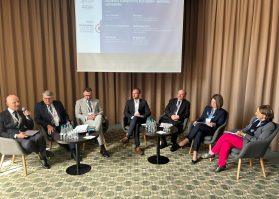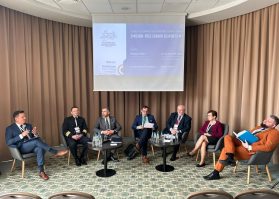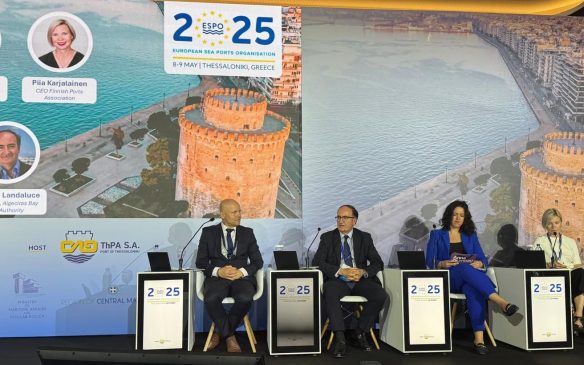The Port of Gdańsk participates in a dialogue on the future of a sustainable blue economy
On the second day of the 11th International Maritime Congress, four discussion blocks were held with a total of 12 panels. The Port of Gdańsk organised a block devoted to the sustainable blue economy including three discussion panels addressing the issues of strategy and regulation, financing and the circular economy.
The first to speak were the following experts: MEP Magdalena Adamowicz (University of Gdańsk), Ernest Czermański (University of Gdańsk), Rafał Machowiak (National Chamber of Maritime Economy) and Monika Żaboklicka (DB Port Szczecin and Szczecin Port Stakeholders’ Council).
The panel ‘The Blue Economy Programme – how to stimulate socio-economic development in the EU?’, was moderated by Dorota Pyć, President of the Port of Gdańsk.
At the beginning of the panel, the moderator reminded the audience that, according to EU documents, the blue economy is the future: low-carbon, resource-efficient, circular, serving to improve people’s prosperity and reduce the impact on the environment.
‘The principle of sustainable development was introduced into Article 5 of the Constitution of the Republic of Poland in 1997. Today sustainable development is present almost everywhere, it is indexed, we must have ESG policies, and we must perform many tasks in this area’, said President Dorota Pyć. ‘The concept we have here today has its own axiology. It is very important, but difficult to translate into a business approach. The bottom line is that we need to protect ourselves from ourselves in the course of development’.
MEP Magdalena Adamowicz emphasised that the reality is changing dynamically: the pandemic, the war in Ukraine, geopolitical tensions – all this forces us to review our high environmental standards. ‘The colours in EU politics are still vivid. Green and blue cannot be more expensive, more difficult or more complicated than traditional solutions – and that’s the way it has been. We need to look at the competitiveness of our businesses. Although some would like to abandon the Green Deal, steps in this direction are inevitable’.
Magdalena Adamowicz discussed three key EU documents. The European Ports Strategy assumes the transformation of ports into energy, logistics and digital hubs supporting the security of Member States. The Maritime Industry Strategy is intended to make it possible to use security funds for dual civil and military applications in ports. In turn, the European Ocean Pact is an integrated approach to the protection and management of marine resources.
Monika Żaboklicka stated that Poland is not ready for a massive energy transition.
‘The current policy is impossible to implement – we don’t know what direction we want to take. We have hydrogen, methanol and ammonia. Hydrogen is good for on-site installations, methanol is suitable for short-range shipping, and ammonia for long-range shipping. Every major port in Poland will have to build at least one installation’, she said.
She added that without a coordinated IMO and EU policy, investment in port alternative fuel bunkering facilities could result in waste. The lack of energy storage capacity is also a problem.
Dr Ernest Czermański, a specialist in maritime spatial planning, argued that despite everything it is possible to manage maritime areas in a sustainable manner.
‘We have good tools – a law and a plan. It is a success that 42% of the area has been classified as a reserve, not assigned to specific functions. The areas that are the subject of the greatest interest of various users have already been defined, so there should not be many conflicts here, as they were resolved during the public consultation stage’, he said.
At the same time, he drew attention to urban planning problems.
‘The relationship between ports and cities is not well regulated. Port authorities and city authorities are fighting over the waterfront’, he said.
At the same time, he called for the creation of general European directives that would allow countries to develop their own strategies consistent with them, but taking into account the specific characteristics of each country, its capabilities, needs and ambitions.
Rafał Machowiak emphasised that in the current situation, our competitiveness depends on the energy sector and the success of decarbonisation projects. The Polish system is largely based on power plants from the 1970s, while the strategies for transitioning to renewable energy sources have a long-term perspective.
‘For every job created on the port’s management board, there are 58 jobs in the port’s vicinity and 1,790 jobs in the country. The problem is that these 1,790 people are often unaware that they are part of the maritime economy’, he added.
Sustainable economy and money
Alan Aleksandrowicz, Vice-President of the Port of Gdańsk, during the second panel discussion, talked with his guests about sustainable ports in the blue economy in the context of investment and financing. The discussion was attended by: Janusz Jarosiński (Vice-President of Comal), Piotr Krahel (Szczecin and Świnoujście Ports Team), Sylwia Majkowska-Szulc (University of Gdańsk, Port of Gdańsk), Monika Niemiec-Butryn (Ministry of Infrastructure), Piotr Porzycki (CMW Legal, Szczecin Port Stakeholders’ Council) and Marek Tarczyński (Terramar, Polish Chamber of Forwarding and Logistics).
The discussion revolved around geopolitics and public financing in the European Union, which is crucial for the development, implementation and use of blue economy technologies and projects that influence, for example, the development of sustainable transport and seaports.
‘Black swans, the pandemic, the war in Ukraine, the blockade of the Suez Canal by Houthi rebels, further armed conflicts in Gaza, now the conflict on the border between India and Pakistan, and on top of that the effects of Donald Trump’s presidency and his new vision of foreign policy, which marks a return to American protectionism, as well as the dynamic development of Asian economies while, on the other hand, the progressive loss of competitiveness on a part of European industry, which we can see, for example, in the automotive industry – all this means that the assumptions made in 2019 are undergoing a revision before our very eyes. I’m talking about the action plan known as the European Green Deal. The goals set 6 years ago had to be revised. A new action plan, called the ‘Clean Industry Package’, has been developed. A package of simplifications for the implementation of sustainability goals and reporting, known as the Omnibus package, was also developed. Work on the new EU budget continues. The old perspective ends in 2027. The European Commission is dynamically working on a new perspective for the period after 2027. In this context there are three key areas of action, referred to as 3D (Decarbonisation, Digitisation, Defence), that come to the fore’, said Alan Aleksandrowicz.
In Poland, we continue to rely on the strategic document ‘Seaport Development Programme until 2030’. This perspective is slowly coming to an end. This document, adopted in 2019, is based on an even older document: the 2017 Strategy for Responsible Development.
The existing decarbonisation goals, including net-zero by 2050 and a 20% reduction in emissions by 2030, seem increasingly unrealistic. Upcoming EU regulations, including the new port strategy and the EU budget for the period after 2027, may introduce a new framework for the operation of ports. There is also an ongoing discussion on the use of ETS funds in the maritime sector’.
He also emphasised that investments in the blue economy, i.e. modern, energy-efficient investments, are large capital-intensive investments requiring huge financial outlays, amounting to hundreds of millions of zlotys. They should therefore correspond to real needs and economic trends. They should meet the new role of ports, a role that is already emerging. Ports are becoming key places for energy, food and military security.
Marek Tarczyński was asked about his opinion on the investment programme in Polish ports. He described it as ‘accurate and properly implemented’.
‘The expectations of foreign trade and transit have been met. The only commodity group that Polish ports have failed to cope with is Ukrainian grain’, he said.
He pointed out that the border blockade by farmers and carriers had harmed the interests of the port sector. He added that Baltic Hub, after losing cargo from Russia and Belarus, had filled the gap with containers from Ukraine.
Can ports and shipping succeed? Decarbonisation targets for 2030 and 2050
The third panel discussion organised by the Port of Gdańsk focused on the energy transition of shipping and ports in the context of the circular economy. The discussion was moderated by Dominik Landa, Director of the Strategy and Development Department at the Port of Gdańsk, and the participants included: Mateusz Herbot (Polska Żegluga Morska [Polsteam]), Krzysztof Kołwzan (Polish Register of Shipping), Bogdan Ołdakowski (Baltic Ports Organisation), Barbara Pawłowska (University of Gdańsk), Stefan Rudnik (Port of Gdańsk) and Wojciech Zdanowicz (Maritime Office in Szczecin).
Dominik Landa began by pointing out that OPS (Onshore Power Supply) systems, which allow ships to use electricity from the land while docked in port, are one of the solutions of the future.
This not only saves fuel, but also significantly reduces emissions in urban areas. It is interesting to note that by 2050, the installation of such systems will become mandatory in all European ports and in most ports around the world, initially for container ships and passenger ships.
‘The most vocal advocate of OPS systems was Arnold Schwarzenegger himself – actor, former governor of California and active promoter of the green transition. And it was California, one of the richest states in the US, that was one of the first to introduce mandatory OPS systems. These systems are effectively implemented there’, he said.
During the panel discussion, Dominik Landa also drew attention to the changing global fleet:
‘Did you know that as much as 69% of container ships currently ordered from shipyards – mainly in China and Korea – are vessels adapted to LNG propulsion? But remember: LNG is not a green fuel. It is only a temporary solution. As far as methanol is concerned, we currently have 166 ships on the order book, and 27 powered by ammonia’, he said.
He pointed out that future green technologies cannot be more expensive than those currently in use if ports and shipping are to remain competitive. He noted that although maritime transport accounts for only 3-4% of emissions in the EU, its global importance is enormous. ‘If the ocean was a country, it would be the eighth largest economy in the world’, he said.
Mateusz Herbot pointed out that biofuels are alternative fuels that are actually used. The Polonia ferry, operated by Unity Line, burns 100% biofuels, which means that the entire fleet falls within the green part of the FuelEU Maritime regulation.
‘We buy it for EUR 1,700 per tonne, but it pays off because we reduce our participation in the ETS. In the long term, hydrogen is the most promising synthetic fuel. However, it must be manufactured from renewable energy – otherwise, there is no point in talking about zero emissions. E-methanol could be a transitional synthetic fuel, because the current bunkering infrastructure, ship systems and engines can handle it after a small retrofit’, he said.
Wojciech Zdanowicz emphasised the role of the state as a regulator.
‘We are going to verify whether ships and ports meet the requirements, whether they actually reduce emissions and whether to impose penalties if they fail to meet these requirements’, he said.
He pointed out that although the fuels of the future are e-methanol and e-ammonia, there is currently a lack of fuel manufacturers and ports must rely on what is actually available.
Bogdan Ołdakowski pointed out that ports cannot be ready for a fuel that does not yet exist. In his opinion, infrastructure development depends on a clear signal from the shipping industry:
‘If shipowners choose methanol, ports can organise logistics facilities, including bunkering infrastructure, without any special conditions. The LNG transition also began with bunkering from tankers and barges, but the business adapted over time.
When asked about the time needed to adapt the ports, Stefan Rudnik replied that the average investment period is approximately 6 years, taking into account environmental decisions. However, he pointed out the difficulties in producing green energy in ports:
‘Each modernised quay in the Port of Gdańsk is “OPS-ready”. But how can we provide this clean energy? We must build our competitiveness not on the mere fact of connecting ships, but on the fact that the energy supplied to them is green, because this is what shipowners will be interested in when determining their emissions’.
He added that, unlike ports in Western Europe, it is not possible to erect wind turbines in Gdańsk due to the proximity of urban buildings and what is known as the wind turbine law.
In accordance with the regulations, from 2030 ports will have to provide OPS (onshore power supply) for ships over 5,000 GT.
‘This is not something that ports are going to profit from. The cost of seven OPS systems on the quays in Gdańsk is PLN 295 million’, said Rudnik. ‘The project requires doubling the port’s connection capacity and building new underground infrastructure. We are going to be ready by the end of 2029, provided that the procedures are not delayed.
Wojciech Zdanowicz reported that in four Polish ports of key importance to the economy, only 20 quays requiring such facilities have been identified, while 35% of them are already in the design or construction phase.





